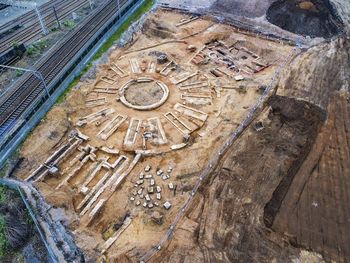HS2 Phase One: London to West Midlands Historic Environment Digital Archive
High Speed Two Ltd., 2023. https://doi.org/10.5284/1110091. How to cite using this DOI
Data copyright © High Speed Two Ltd. unless otherwise stated
This work is licensed under a The Open Government Licence (OGL).
Primary contact
High Speed Two Ltd.
2 Snowhill
Queensway
Birmingham
B4 6GA
United Kingdom
Tel: 08081 434 434
Resource identifiers
- ADS Collection: 4061
- DOI:https://doi.org/10.5284/1110091
- How to cite using this DOI
Introduction

Phase One of HS2 is the new high speed railway line between Euston, London to north of Birmingham, where it re-joins the existing West Coast Mainline. The new line between London and Birmingham runs on 140 miles of dedicated track. Four brand new stations and two new depots have also been built.
The Phase One route extends across the grain of the landscape of southern and central England through varying geologies, topographies and regions. The nature of its design means that it tends to avoid topographic extremes and heavily built up areas, excepting Birmingham and London where the opportunities for the investigation and study of the post-medieval urban landscape of these two metropolises have been realised.
Well over 10,000 years of history are being revealed from early prehistoric settlements through to post medieval burial grounds. Some of the earliest activity recorded appears to focus on river valleys and their tributaries in the Colne Valley at Hillingdon and the River Great Ouse in Northamptonshire. Funerary and ceremonial monuments of the Late Neolithic and Early Bronze Age have been less frequently identified, but highlights include a timber circle at Wellwick Farm, Wendover. A wide variety of Iron Age and Roman settlements have been recorded across the route with significant and extensive systems of enclosure and land division. These sites have potential to reflect cultural and economic diversity across broad areas. Early medieval and Saxon buildings have also been identified, along with examples of burial sites of the period. Medieval villages have been recorded at Doddershall in Buckinghamshire and a 15th century moated manor house and gardens at Coleshill in the West Midlands. Evidence of our industrial heritage is evidenced by the World's earliest railway roundhouse at Curzon Street, Birmingham. Post medieval burial grounds have been excavated in Birmingham and London revealing the people that were part of the growth of the cities. At Stoke Mandeville, 900 years of history are revealed at St Mary's.





